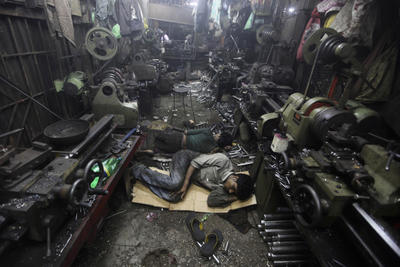But while utilising the labour force should not amount to exploitation or curtailing democratic rights of workers, archaic labour laws intended to be labour-friendly have had the opposite effect. The problem is one of means and ends. Current labour laws in India require firms of over 100 employees to obtain government permission to sack employees, even if they are unproductive. Furthermore, firms find it difficult to exit in the face of financial loss, unprofitability or any other good reason to shut up shop. These and other restrictive clauses discourage firms from investing in Indian manufacturing.
In 2013, the manufacturing sector contributed only about 15 per cent to India’s GDP, the lowest in a decade. In fact, for several decades the manufacturing sector’s contribution to GDP has remained stagnant at 17 per cent. An underdeveloped industrial sector leaves herds of unskilled Indian youth jobless, giving credence to the possibility of an impending demographic disaster.
So what can be done about it? Reforming labour laws and soliciting export-oriented FDI — something the United Progressive Alliance did not do in the ten years it was in power — could be a good place to start.
In India there are an additional 10 million low skilled workers every month. To create sufficient jobs, large scale manufacturing needs to expand. For this to happen, India needs to become an attractive place in which to undertake manufacturing, and from which to export. In short, it has to become a hub of manufacturing for global export, not just domestic consumption.
Export-oriented FDI has the potential to vault India into the league of industrial economies: a stage which it allegedly skipped on its way to becoming a post-industrial service-based economy. Unlike the predominant market-seeking FDI, export-oriented FDI is labour — and employment — intensive. In 2001, foreign affiliates accounted for only five per cent of India’s total exports. In the same year in China, foreign invested enterprises made up 50 per cent of total exports. In China export obligation is mandatory for foreign investors. This is not the case of India. Export obligation for FDI should be introduced in India to enhance exports.
Export-oriented FDI requires quality physical infrastructure. Thus, a major bottleneck of poor infrastructure must first be dealt with. In this area, massive state investment combined with private sector partner support can rescue India from this sorry state.
From high speed trains to upgrading ports to power sector reforms, Narendra Modi has so far made the right noises. Given that uninterrupted power and seamless transport infrastructure are two crucial demands of the manufacturing industry, it is a good sign that energy and infrastructure form the core of the new cabinet’s economic policy focus.
Modi, widely seen to be a clean pair of hands and a tough taskmaster, is likely to ensure a corruption-free government. At the same time, transparency and an end to unchecked discretionary powers will help to gain the faith of the corporate sector, which has held back investment plans over the last few years of policy paralysis. Once infrastructure is in place, trade and transactions costs will fall, giving a further boost to manufacturing and exports.
In terms of labour cost, India is not at a disadvantage relative to China or East Asia. India’s wage levels are more or less at par with these economies. Additionally, India has one of the best stocks of raw materials in the world and an abundance of workers. Thus as far as factor endowments are concerned, India possesses the bedrock of a thriving manufacturing sector.
Yet it would be irrational to have a single-minded focus on low-skill manufacturing in India at a time when the country has already made strides in the services sector, including in high value-added services. What is needed now is for India to treat manufacturing and services as the two equally important pillars of its economic foundation.
The government should focus on labour-intensive manufacturing for the vast swathe of the low- to medium-skilled populace, while simultaneously undertaking a national skills mission, boosting research and development spending and improving the quality of education at all levels. FDI on its own accord will contribute to some of the above while developing useful production linkages with the local economy.
As in China, export-oriented FDI can help fortify India’s domestic manufacturing base. Much of the recent sophistication and value addition in China’s manufacturing export basket is also largely due to FDI in the sector. A synchronisation of India’s export and FDI policies is needed. This can be achieved by increasing FDI in export-oriented sectors like gems and jewellery, light engineering, goods and textiles, among others. Up till now, FDI in India has been concentrated in telecom, infrastructure and financial services.
Eventually rising exports, on the back of growing export-oriented FDI, will help India address its troubling trade deficit. One of China’s great success stories — and a reflection of effective policymaking in that country — is that it built a trade surplus by exploiting FDI sourced from various parts of the world. Prime Minister Modi often talked of rivalling China on many issues, including commerce, during his election campaign. Encouraging export-oriented FDI would be a winning strategy to translate those assertions into meaningful action.
Abhirup Bhunia is a research analyst at the Institute of Economic Growth in New Delhi.
Geethanjali Nataraj is a senior fellow at the Observer Research Foundation in New Delhi.

